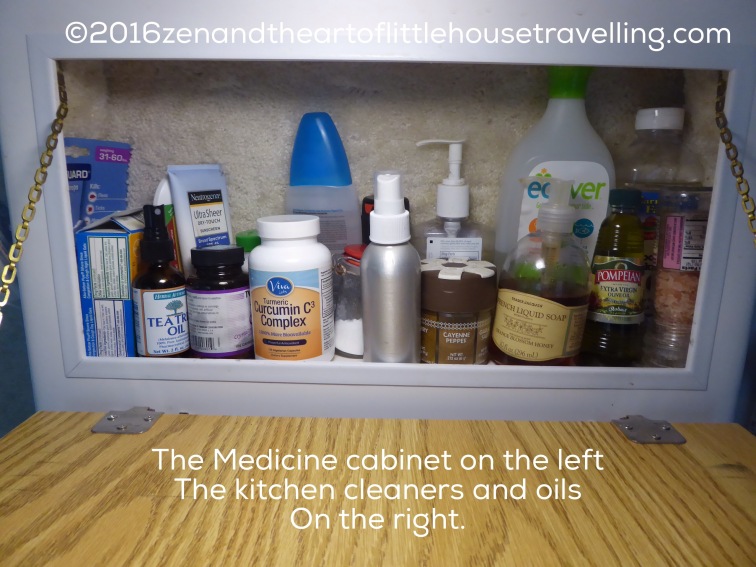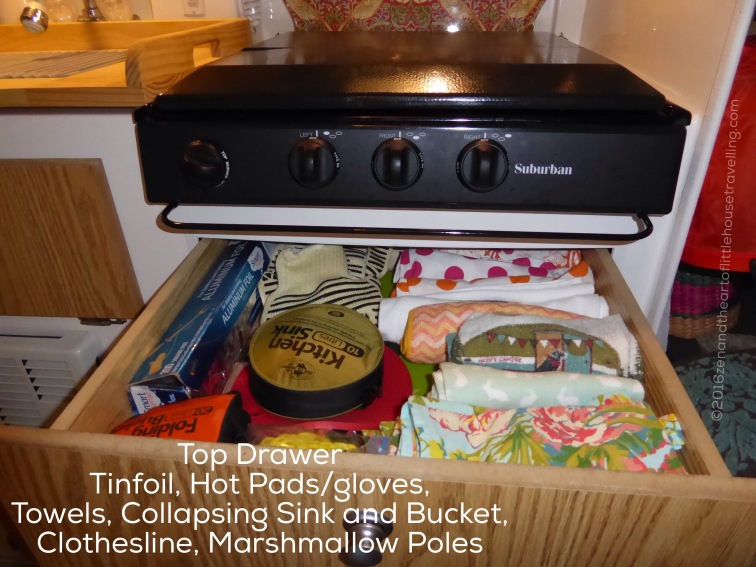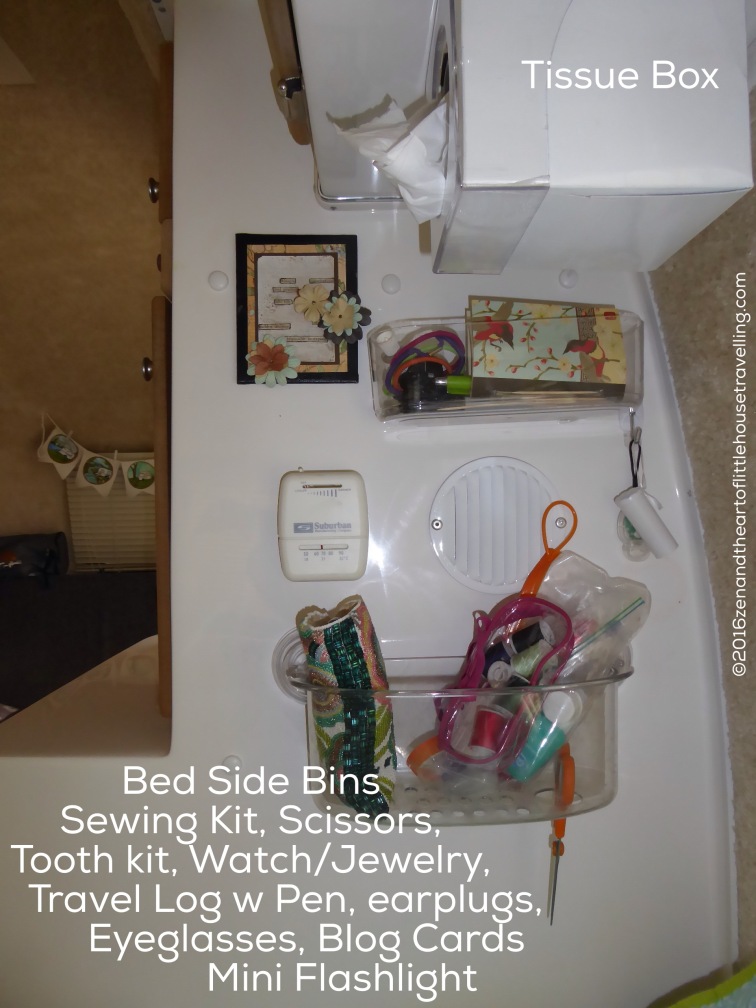Well if you’ve been reading along to this point, you know we like things “pretty”, frugal, practical, natural, dog-friendly and tasty-good food. The trick is how to pack a small space to be prepared to do the all things you love at a moment’s notice–and not bring so much you can’t easily see and stow it.
If cleanliness is godliness then clutter-free is heavenly-ness.
What we can get right is the core pack of camping niceties. Now, everyone is different and has unique preferences, so no two lists or Eggs will be alike. For us, we like eating on enamelware dishes most of the year and paper plates in winter. We don’t like to eat from plastic so we only carry a couple of plastic cups (monogrammed of course, lol) and a pair of backpacker’s plastic removable stem wine glasses–we have a no glass rule. I didn’t want to buy new pots or kettles so some of our gear is compact from our years as tenters. We drink tea and not coffee so we aren’t encumbered by all that coffee requires.
Now, I like cooking and making something for the Hub that puts a smile on his face. I started out cooking mostly outdoors when we had electric hook ups. For that I used a hotplate but soon found that to be a pain in the neck because my little folding table seemed to never be on level ground and that meant pots wanted to slide off the hotplate. (I have changed the table I use for this now and it has self leveling legs but that will be another post).
So, I bought my first ever electric skillet when I found that Presto made one that folds down. This was infinitely more practical for me than the hotplate so it now sits unused in the garage except for the occasional holiday cookout when I need more burners. I missed baking things so I played around with my electric skillet and can use the electric skillet for baking and cooking. It fits nicely on top of the stovetop cover for when I want to use it inside for pancakes, etc. (So happy we got that stove cover, btw).
With the advent of our solar panel set-up, we found we were camping in basic sites or boondocking far, far more than full hook up sites. That is really what moved me to start cooking indoors more often. I do still use my Bio-Lite stove because it can cook on twigs or charcoal. When I know we’ll be in a sunny spot I play with our Go-Sun solar oven, too–though I don’t bring these stoves every time now. In winter I use a Dutch oven and cast iron pan over the fire pit. But what I’ve found on regular trips is; it’s just so easy to turn a knob and use the inside stove on short trips and one nighters en route.
Ours is the three burner stove and the burners aren’t laid out ideally to get three pots on it at once–that takes a little finessing–but I’m happy cooking there. I cook all kinds of smelly things from salmon to curry to caramelized onions in there and the stove vent clears the scents right out. That fan is close to the food so it performs very well.
So now that you know how we roll, the choices for our kitchen galley are as follows:
The bin above the stove is shallower because of the stove vent. We keep the dish mat, handpainted pitcher (in a protective shoe bag), an oversized cooking mug, the folded X-Pot, silicone veg steamer and some extra linen napkins and a rag rolled up in there. We are careful not to overpack or put heavy items up here so shifting contents won’t force the doors open on a bouncy road.
The bin over the sink holds all the enamelware (paper plates in winter), the liquid measuring cup, the little pitcher I use to make iced tea, the insulated mugs, the backpacker’s wine glasses(one nod to plastic stemware because we don’t pack glass) the collapsable bowl and the lids that go with the enamelware bowls, etc.
The Flip down cabinet just above the sink is one of my favorites because it makes for extra workspace and it holds the taller items like bug spray, soap and cooking oils right where you need them.
The drawers below the stove are the real workhorses. All the little kitchen tools go in there. Our first rule is everything must have a place and be completely visible. We found that if a cabinet is cluttered in this tiny space, it can easily lead to a tired frustration. So, rule number two is keep it simple, keep out frustration.
The top drawer holds the foil, the towels, hot pads/gloves, the collapsing buckets and laundry line, etc.
The bottom drawer holds all the silverware and little tools like the bread knife, citrus reamer, micro plane, outside wine glass holders, electric travel water heater, tongs, small can opener, bottle opener, silverware roll, measuring tools, etc.
The cabinet below the drawers is for the bulky electric skillet with its silicone pans and racks stored inside in stuff sacks. (Note: stuff sacks really help keep me organized and things from scratching), the grill grate (for fire cooking), the 10.5″ frypan w universal silicone lid, the nesting JosephJoseph boxes, dog tie-outs with a bag of pick-up bags, stovetop toaster, etc.
The flip drawer in front of the sink holds the lighters, matches, extra sponges, mini bar soap, rubber bands and the essential tick puller.
The bin below the furnace holds the lidded soup pots, and the cast iron pan and dog cable. (Note: the fry pan is the only one with a handle. Even my iron skillet has two short handles rather than a stem so that they can be stowed easily).
The bin above the pantry (We chose a pantry instead of a microwave and so thankful we did) holds the gear. From things like little games to the wet case for the camera and eyeglass holders for canoeing to the remote temperature gauge to headlamps all the way through to the 3-way 12v splitter with a built-in volt meter, etc.
We don’t use the bins under the bed, except for the front two, because they are so hard to get to. The front two bins hold our water shoes, hiking boots, the hand crank blender, the laundry gizmo and a nylon backpack and duffle bag that fold into themselves compactly. We use those bags if we are overnighting in someone’s home along the way or for picnic hikes where we need to take more stuff along. Those little bags have proven very handy and I’ll write a mini-post on them next time we have them out. This means all the decorative pillows hold the extra sheets, towels and blankets.
The fiberglass walls become places for great storage using command hooks and suction cups (note: in our sauna Midwest, suction cups hold on well. Occasionally, in the dry winter, we’ll have to re-position one or two.)
Because we don’t have a wet bath (our shower is outside on the back of the trailer), we have a front bunk. There, we store the TP, chems, extra paper towel roll, garbage bin liner bags, the porta-potty, a soft cooler filled with the heavy pantry items like cans, bottles, etc.) the picnic tablecloth, bench pads, dog life preservers and other bulky things. We keep our shower shoes and an extra leash handy right by the door on the front of the bench.
As for clothes, we each get two bins above our sides of the bed. We keep about 5-7 days worth of clothes up there by rolling everything into tight rolls–again, making everything easy to see to lessen any frustration. The front bin has our underthings and shirts, the back bin holds the second pair of shorts and pants, the Dopp kits, and clothing miscellany. The very back center bin is where we keep the bulky sweaters and rain jackets. If we are out for a longer period, we keep a weatherproof clear storage bin in the car with the fresh clothes. 
So, that’s most of our organization. Since we don’t have a sewer hose, we use the back bumper for the back-up sighting poles and the poles I use for the picnic table lighting system described in another post. We do travel with the chair umbrellas, outside rug, folding table and two of the folding chairs in the slot under the bed. We have a big grey bin in the car for all the leveling gear, Kelty awning, a clear tool box for all the things that get re-charged,  the 12v fan, etc. Maybe next trip I’ll shoot a picture of our Traverse with the gear in it and write that up.
the 12v fan, etc. Maybe next trip I’ll shoot a picture of our Traverse with the gear in it and write that up.
Note: Another nice thing about not having a wet bath is there is a slot between the stove and the bunk that slots in our solar panels nicely for travel and holds our shoes out of the way at night. I’ll try to remember to get a follow up picture of that, too.
So, I hope this helps some of you. It sure took a lot of effort to get it all onto the blog. If there is one thing to take away from all of this it’s too keep editing what you are not using and keep everything in its space and very visible. The trick to happy camping in a tiny space is limiting frustrations. The easiest way to do that is orderly cabinets and not having to rummage for the thing you need.
So, if something isn’t clear, ask away and I’ll try to clarify. As always, if you like the posts, please “follow” by clicking on the box in the lower right corner and share with your camping friends.
©2016zenandtheartoflittlehousetravelling.com. All rights reserved.


Brillllliant post ~ OH SO HELPFUL!! I’m keeping this very close…for when we once & for all, get inside our egg and begin to load in our essentials! It’s outside our home right now, under cover (the central Fla. heat will be with us, for a good while yet). You’re just ~incredible~ with these details!! Thank you soooo very much!!
LikeLike
You’re so welcome Donna. You’ll find just the right mix for yours and what fits your style! One piece of advice is to go with just the basics and keep a list of things you wished you had on the latest trip. Edit and re-edit.
Even when I was taking the pictures I found a half dozen or so things that had snuck in that we weren’t using anymore.
LikeLike
Is that electric frying pan the 12″ or the larger 16″?
LikeLike
The square 12″. It fits the round silicone cake pan well.
LikeLike
I’m so enjoying your post. I need all the organizing ideas I can get and you’re a pro in that field.
LikeLike
It takes commitment to tidy when you are travelling small–that and a constant editing if you aren’t using it, it doesn’t go.
LikeLike
I am very interested in where you got your sink cover?! It looks like it has a drainage center. Brilliant! We decided after reading your posts, to order the Indepence. Thank you for all your wonderful suggestions…
Did you make the sink cover? Have it made? I would love one exactly like it. Thank you!
LikeLike
Hope you love yours as much as we love ours. Yes, I invented that little Sinkboard and it is essential because there is no counter space otherwise. I plan a blog post on meals and holidays in the Egg and you’ll see why I needed that sink board.
The details for it are here: https://zenandtheartoflittlehousetravelling.com/2016/04/08/another-new-invention/
LikeLike
For anyone who does need hot coffee every morning, we use a French press. It takes up way less space than a conventional coffeemaker. If we have electricity we use a hot pot to heat the water for it. If we are boondocking we use the gas cooktop to heat the water.
LikeLike
Where did you find your sheets? Do you have or know where I can find a) a Casita machine embroidery pattern and/or b) an applique design? I’d love to make some pillows, sheets, towels, etc. Thanks
LikeLike
The sheets were everywhere when I bought mine. Camping World had them. I think I found mine online. I know they were at a closeout price.
I only do hand embroidery. I contacted an Etsy seller to make our embroidered hats. She was able to make them custom for us.
LikeLike